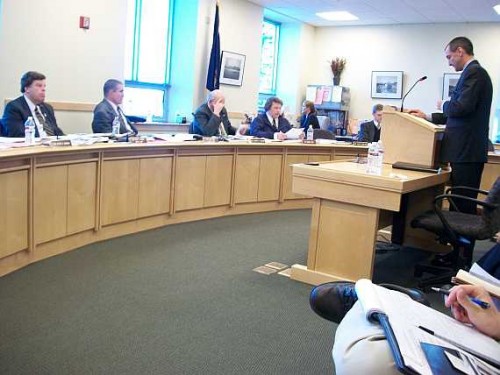LD1810, the Maine Legislature’s bill LD 1811,to authorize offshore wind leasing seems to be coming apart interestingly. Instead of filling state waters with windmills – a plan that enraged Maine’s fisheries, a new plan has emerged. By Tuesday night we’ll know if it has been adopted. It would be something like this:
It would be something like this:
1. State Waters: Rather than follow “old Europe” by clogging up our nearshore coastal waters with windfarms, Maine will preserve her inshore waters for existing users. No windmills in state waters except for those R&Ds off Monhegan. Tidal and wave based power extraction may still be allowed – on small scales? Tidal won’t work easily in deep water.
2. Federal waters. Leapfrogging windpower extraction straight to floating windmills ten miles out and more. Skipping the shallow waters entirely.
3. Given that offshore electricity has to get to an on-land power grid, the plan is to run that issue of powerlines coming ashore past all the affected communities – municipalities fishing, tourism, aesthetes, etc, then come back in 2012 with recommendations In the interim, coastal towns and water dependent interests sprout protective ordinances or regulations.
Dr. Habib Dagher, director of the University of Maine’s offshore wind program, told the legislators at the worksession last thursday that floating offshore wind extraction is the answer.
“Rather then build fixed base units in shallow waters, which take a lot of equipment to build (it’s like like building a boat in the middle of the ocean and affixing it to the bottom of the ocean, thats what the Europeans are doing), we want to build like Bath Ironworks does: build it in a drydock. Float the drydock and tow the whole thing out to deep water.”
“In terms of Maine’s timeline: our goal is build our first demonstration floating turbine, a third-scale turbine about 120 feet above the water – next year and place it in the water the year after in the Monhegan site.” Following that, and shaking the bugs out of it, in 2013 we would build the first 4 or 5 megawatt unit, and place that in the water. Following that in 2014 and 2015, build our first “stepping stone” farm – a 25 megawatt farm. The next phase: development of the large scale 500 to 1,000 megawatt farm. We have at least one developer interested to do that and have it operational in 2020.”
The Maine Lobstermen’s Association’s Patrice McCarron responded to Dr Dagher:
“We wholeheartedly support this offshore development. Obviously it passes by the majority of where my stakeholders make their living. So that’s a no-brainer. When I look at the language here, though; because the bill is so comprehensive, and because its laying out the regulatory process to establish this in state waters – which I fully understand can happen anyway, and probably is a blessing in disguise – it scares me.”
“What’s missing for me after taking in all this comment, is the legislative findings of the bill which begin on page 14 and page 15; the sections A-1, 2, 3 and 4. It doesn’t clearly state that this is the state’s goal: to pass over this existing technology in state waters, and really focus where the wind resources are greatest. Those are strictly legislative findings, but for me it really sets the tone for the values and the goals of the state, and I’d like to look at potentially strengthening that and clarifying what the true intention of this is.”
By tomorrow night, we’ll know if Dagher’s Point hits the target: no windfarms within ten miles of shore or inhabited islands, to protect existing nearshore users, except for Monhegan which, Christlike, would allow its ineffable beauty to be scourged and, yea, sacrificed, for the greater good of of the rest of marine Maine.
Then again, there’s a little lawsuit pending, which may keep Monhegan’s views and sonic landscapes free of the lash.